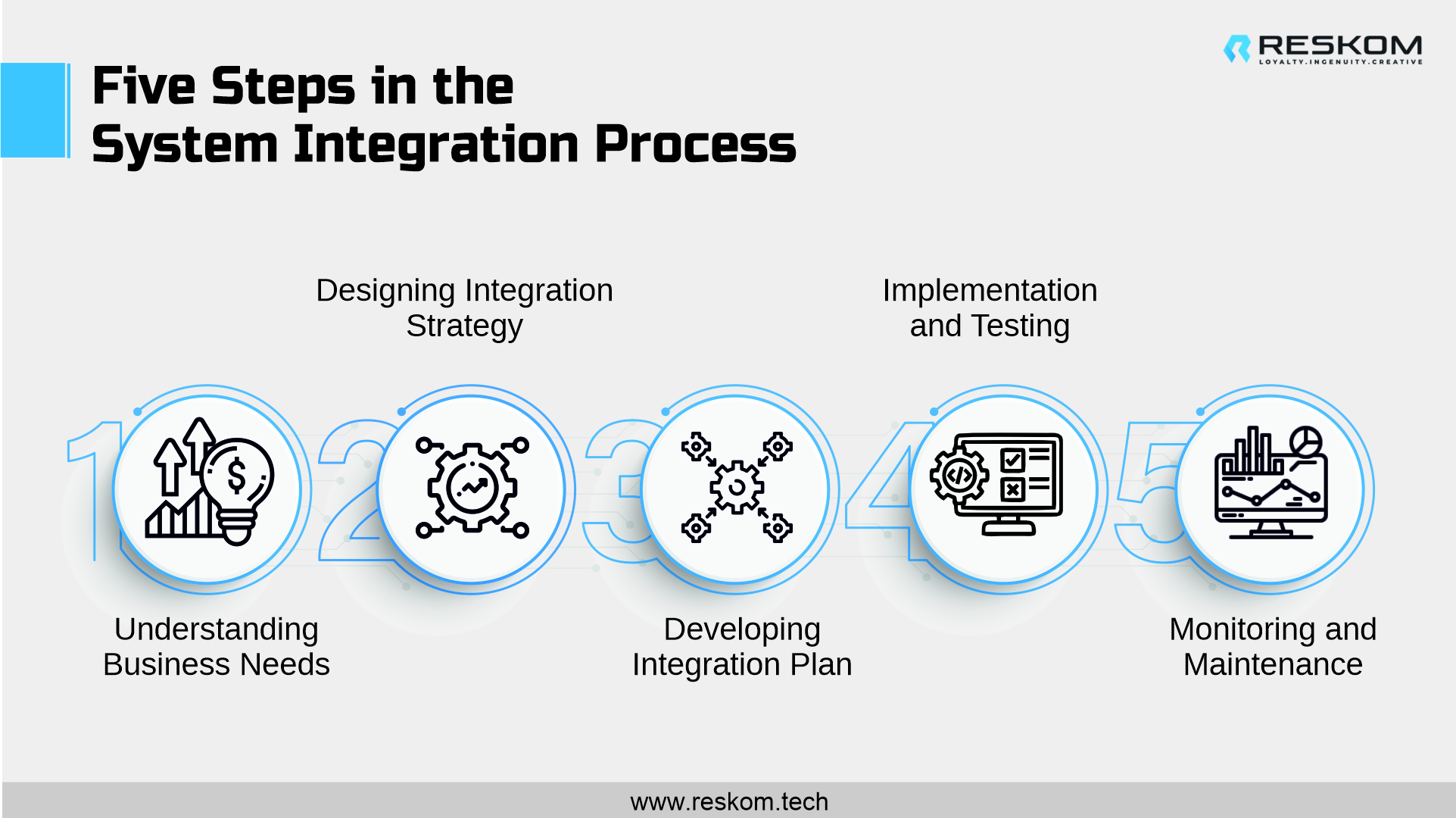The process of system integration emerges as a pivotal solution to bridge the gaps between diverse components and ensure a cohesive digital ecosystem. System integration involves the strategic alignment of various software systems, enabling them to work harmoniously and exchange data seamlessly.
This process isn’t just about connecting software; it’s about creating a unified digital landscape that drives efficiency, productivity, and informed decision-making. To achieve this integration nirvana, organizations embark on a journey that encompasses a series of well-defined steps. Let’s delve into the intricacies of the five key steps that constitute the system integration process.

Step 1: Understanding Business Needs
At the heart of successful system integration lies a deep understanding of the unique needs and objectives of the organization. This foundational step involves close collaboration with stakeholders from various departments to identify the specific business processes that require integration. These processes could range from customer relationship management and supply chain management to financial reporting and human resources.
By immersing themselves in the nuances of these processes, integration experts gain insights into the flow of data, communication requirements, potential pain points, and overarching goals. This understanding serves as the bedrock upon which the entire integration strategy is built.
Step 2: Designing Integration Strategy
Once the organization’s needs are crystallized, the next critical step is to design a comprehensive integration strategy. This strategy delineates the approach that will be adopted to seamlessly connect disparate systems. Organizations can choose between point-to-point integration, where specific systems are connected directly, or middleware-based integration, where a central platform facilitates data exchange.
The strategy also encompasses the selection of integration patterns, communication protocols, and data transformation techniques. This step is akin to charting a course for the integration journey—a roadmap that guides how systems will communicate, share data, and collaborate.
Step 3: Developing Integration Plan
With the integration strategy in place, the process moves forward to crafting a detailed integration plan. This plan translates the strategy into a concrete action plan, outlining the sequence of steps required to connect the systems effectively.
It entails defining the specific integration points where data will be exchanged, mapping the data fields between systems, setting up transformation rules to ensure data compatibility, establishing error-handling mechanisms, and implementing data validation processes. Each detail in the plan is meticulously thought out to ensure a seamless flow of data and minimize disruptions during the implementation phase.
Step 4: Implementation and Testing
As the plan takes shape, the focus shifts to the heart of the system integration process—implementation and testing. Integration experts work diligently to execute the integration plan by configuring the necessary connectors, APIs (Application Programming Interfaces), and middleware components. This phase is characterized by meticulous attention to detail, as every element must align to ensure accurate data exchange and proper functioning of the integrated solution. Rigorous testing is paramount, encompassing scenarios that mimic real-world data flows, error scenarios, and performance testing. It’s during testing that any inconsistencies or issues are identified, addressed, and rectified, ensuring a smooth transition to the integrated system.
Step 5: Monitoring and Maintenance
The culmination of the integration process marks the beginning of a new phase—ongoing monitoring and maintenance. The integrated solution is now operational, but the journey is far from over. Regular monitoring is essential to ensuring that data continues to flow seamlessly, systems perform optimally, and errors are promptly detected and resolved.
This phase involves real-time monitoring of data exchanges, system performance metrics, and error logs. Additionally, as the business landscape evolves, updates, enhancements, and optimizations are carried out to ensure that the types of system integration solution remain aligned with changing business needs and evolving technology trends.
Integrated Management System: Navigating Complexity with Cohesion
As businesses traverse the intricate realm of technological advancement, the notion of an integrated management system emerges as a guiding compass, steering organizations toward streamlined operations and data coherence.
An integrated management system represents the culmination of efficient system integration, harmonizing diverse software components under a singular umbrella. This integration transcends individual software applications, fusing them into a unified ecosystem where communication is seamless and data flows harmoniously. The objective? To provide decision-makers with a holistic view of operations, facilitating well-informed choices that drive productivity and growth.
Types of System Integration: Unraveling the Web of Connectivity
Within the sphere of system integration, various approaches and methodologies flourish, each tailored to address distinct organizational needs. One of the most prevalent classifications is based on the degree of connectivity—ranging from simple point-to-point integration to comprehensive middleware-based strategies.
Point-to-point integration establishes direct links between specific systems, facilitating efficient data exchange between them. Middleware-based integration, on the other hand, employs a centralized intermediary layer, expediting data flow and enhancing scalability. Moreover, systems can be integrated in real-time or batch processing modes, depending on the immediacy of data exchange requirements.
In the broader landscape of business, effective system integration transcends mere technology; it weaves an intricate tapestry of efficiency, collaboration, and data-driven decision-making.
Understanding the five pivotal steps within the system integration process and recognizing the potential of integrated management systems and diverse integration approaches empowers organizations to navigate the complexities of the digital age with cohesion and agility. In this symbiotic dance between technology and strategy, businesses unlock the potential to orchestrate a harmonious symphony of operations that resonates with success in a digitally interconnected world.
Conclusion
In the grand symphony of modern business operations, system integration serves as the conductor, orchestrating the harmonious collaboration of disparate software components. The intricate process of the integrated management system isn’t just about technology—it’s about enhancing efficiency, streamlining operations, and enabling informed decision-making. Organizations can create a digital landscape where systems communicate effortlessly, data flows seamlessly, and processes operate synergistically with the types of system integration.
This can be achieved by diligently following the five critical steps. These steps are understanding business needs, designing a strategic integration approach, developing a comprehensive plan, executing with precision, and ensuring continuous monitoring and maintenance. As the technological landscape continues to evolve, the significance of effective system integration remains unwavering, propelling businesses toward success in a digitally connected world.
Unlock the power of streamlined operations through the systematic five-step system integration process. Beginning with an assessment to understand your unique needs, our experts meticulously design, develop, test, and finally deploy the integration solution. Partner with Reskom for expert integration solutions that boost your business efficiency and success. Contact us now to get started!


